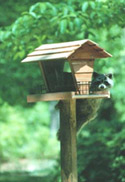Wildlife / Human Conflict
Since the 1950s, some parts of the Southeast have grown exponentially (in numbers of human residents), particularly in Florida. Flourishing development and intensive agricultural practices have caused reduction and fragmentation of habitats. Pollution, exploitation, and the introduction of non-native species have caused habitat loss and wildlife population declines. Despite the bleak outlook, several species have recovered through careful protection and management. That includes the American alligator and the brown pelican.
As homes are built on lands that were formerly wildlife habitat, animal populations increasingly come into contact with humans. Highlighted here are strategies to help minimize wildlife-human conflicts.
-
Nuisance Wildlife
When animals come into your yard or home, they have simply found an element they need for survival (food, water, shelter, or space). These animals can root through your garbage, dig up gardens, or even take up residence indoors. By identifying what is drawing unwanted wildlife to your yard, it is easier to come up with a plan that solves the problem.

Prevention is the first step. Take precautionary measures to prevent unwelcome wildlife:
- Keep garbage in a garbage can with a raccoon-proof lid
- Do not leave pet food outdoors
- Consider fencing garden areas if repeated digging occurs
- Install screens over window, doors, and chimney flues to prevent entry
- Caulk any openings or crevices that animals may crawl through
If problems persist, try using the least toxic and most humane control methods first. Wildlife Damage Management is an integrated pest management program that helps identify problems, and also offers a range of solutions. You can also visit Solving Problems with Your Wild Neighbors.
-
Cats
Free-ranging and feral cats can have a negative impact on the wildlife you attract to your backyard habitat. Cats prey on birds, reptiles, and small mammals, and may also transmit disease to wild animals. The best way to protect your cat (as well as our native wildlife) is to keep your cat indoors.
-
Alligators
Alligators are an important part of the Southeast's ecology and heritage. Their abundant population increases the chance of human-alligator interactions and conflicts. Remember that feeding alligators is against state law, and if you do come across one, do not disturb it. It will eventually retreat away from you.
-
Orphaned or Injured Wildlife
While most injured or orphaned wildlife are picked up by well-meaning people, it is important to realize that such human-animal interactions are sometimes unnecessary. Before deciding to intervene, the most important thing to do is patiently observe the animal in its surroundings and decide if it actually needs help. Many animals may appear to be orphaned, but actually are not. Wild babies are not constantly watched by their parents and spend lots of time alone - with the parent(s) nearby.
If you do come across an orphaned or injured animal, proceed with caution. Remember that the animal may be in pain or shock and can bite. If you do decide to temporarily care for the animal, keep it in a warm, dark, and quiet container for transport to a local licensed rehabilitator. Do not attempt to care for or raise the animal yourself. It is illegal to possess wildlife without proper state permits.



